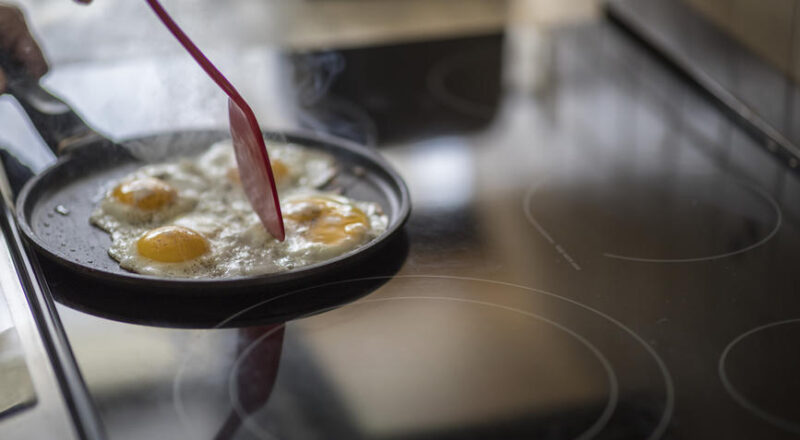When it comes to achieving culinary perfection, using cast iron roasting on induction cooktops can be a game-changer. Many kitchen professionals and home cooks alike are discovering the unique benefits and challenges that come with roasting in a cast iron pan on an induction cooktop. This article will guide you through the nuances of this cooking method, ensuring you achieve perfect results every time.

The Appeal of Cast Iron Cookware
Cast iron cookware has long been revered for its durability, heat retention, and ability to impart a rich flavor to dishes. These pans are perfect for both stovetop cooking and oven roasting, making them a versatile choice for any kitchen. The robust construction of cast iron ensures even heat distribution, which is particularly beneficial when roasting meats and vegetables.
Understanding Induction Cooking
Induction cooking has gained popularity due to its energy efficiency and rapid heating capabilities. Unlike traditional gas or electric cooktops, induction uses electromagnetic fields to directly heat the cookware. This method is not only faster but also more precise, allowing for better control over cooking temperatures. However, it requires compatible cookware, and cast iron roasting on induction is a perfect match due to the metal’s magnetic properties.
How Induction Cooking Works
Induction cooktops use electromagnetic energy to transfer heat directly to the pan, bypassing the need for a flame or heating element. This direct heating method makes induction cooking faster and more energy-efficient. For a deep dive into the pros and cons of induction cooktops, check out this comprehensive guide.
Benefits of Using Cast Iron on Induction
The combination of cast iron and induction offers several advantages:
- Efficient Heat Transfer: The electromagnetic energy directly heats the cast iron, ensuring efficient energy transfer and uniform cooking.
- Temperature Control: Induction cooktops provide precise temperature adjustments, allowing for better control over the roasting process.
- Versatility: With the ability to move from stovetop to oven seamlessly, cast iron is ideal for recipes that require both initial searing and slow roasting.
Challenges and Solutions in Cast Iron Roasting on Induction
While the benefits are clear, there are also challenges that come with cast iron roasting on induction. Here are some common issues and their solutions:
Uneven Browning
Sometimes, achieving even browning can be tricky. To tackle this, ensure your cast iron pan is preheated properly before adding food. For more insights, explore this article on uneven browning.
Cold Spots
Cold spots can occur if the pan is not centered on the induction burner. Make sure the pan is appropriately positioned to allow even heating. This article on cold spots offers more tips.
Smoky Cast Iron
If your cast iron becomes smoky, it may be due to overheating or food residue. Ensure your pan is clean and preheat it gradually. For more information, read about cast iron smoke issues.
Steps for Perfect Cast Iron Roasting on Induction
1. Preheat the Pan
Begin by preheating your cast iron pan on the induction cooktop. Start at a low setting and gradually increase the heat to avoid any thermal shock to the pan.
2. Use the Right Pan Size
Ensure the pan size matches the induction ring for optimal heat transfer. Learn more about matching pan sizes for better results.
3. Season Your Cast Iron
Properly seasoned cast iron enhances flavor and prevents sticking. Apply a thin layer of oil to your pan before each use to maintain its non-stick properties.
4. Monitor Cooking Temperature
Utilize the precise temperature control of your induction cooktop to maintain consistent heat. This is crucial for even roasting and preventing food from burning.
5. Finish in the Oven
For larger cuts of meat or dishes requiring slow roasting, start on the stovetop and finish in the oven. This ensures a perfectly cooked dish with a beautifully seared exterior.
FAQ
Can I use any cast iron pan on an induction cooktop?
Yes, most cast iron pans are compatible with induction cooktops due to their magnetic properties.
How do I prevent my cast iron from smoking?
Ensure your pan is clean, preheat it gradually, and avoid using excessive heat settings.
Is it necessary to season my cast iron regularly?
Yes, regular seasoning maintains the non-stick surface and enhances the flavor of your dishes.

Conclusion
Mastering the art of cast iron roasting on induction can elevate your culinary skills to new heights. By understanding the unique benefits and challenges of this cooking method, you can achieve perfectly roasted dishes every time. Whether you’re a seasoned chef or a home cook, incorporating these techniques into your kitchen routine will ensure delicious and satisfying results. For a deeper understanding of the best pans for induction cooking, visit Le Creuset’s guide.
This article contains affiliate links. We may earn a commission at no extra cost to you.

